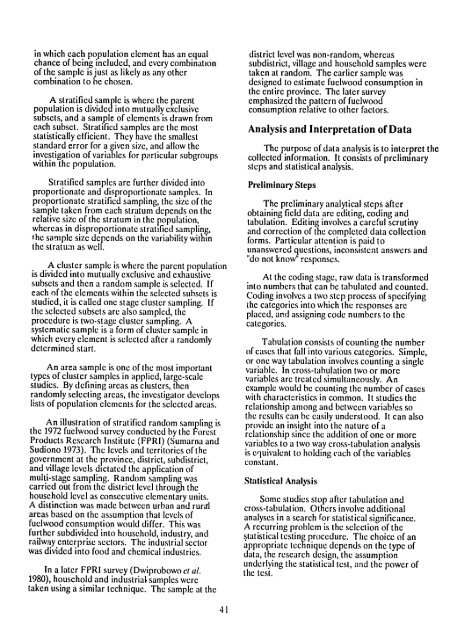multipurpose tree species research for small farms: strategies ... - part
multipurpose tree species research for small farms: strategies ... - part
multipurpose tree species research for small farms: strategies ... - part
Create successful ePaper yourself
Turn your PDF publications into a flip-book with our unique Google optimized e-Paper software.
in which each population element has an equal<br />
chance of being included, and every combination<br />
of the sample is just as likely as any other<br />
combination to be chosen.<br />
A stratified sample is where the parent<br />
population is divided into mutually exclusive<br />
subsets, and a sample of elements is drawn from<br />
each subset. Stratified samples are tie most<br />
statistically etficient. They have the <strong>small</strong>est<br />
standard error <strong>for</strong> a given size, and allow the<br />
investigation of variables <strong>for</strong> <strong>part</strong>icular subgroups<br />
within the population.<br />
Stratified samples are further divided into<br />
proportionate and disproportionate samples. In<br />
proportionate stratified sampling, the size of the<br />
sample taken from each stratum depends on the<br />
relative size of the stratum in the population,<br />
whereas in disproportionate stratified sampling,<br />
the sample size depends on the variability within<br />
the stratum as well,<br />
A cluster sample is where the parent population<br />
is divided into mutually exclusive and exhaustive<br />
subsets and then a random sample is selected. If<br />
each of the elements within the selected subsets is<br />
studied, it is called one stage cluster sampling. If<br />
the selected subsets are also sampled, the<br />
procedure is two-stage cluster sampling. A<br />
systematic sample is a <strong>for</strong>m of cluster sample in<br />
which every element is selected after a randomly<br />
determined start.<br />
An area sample is one of the most important<br />
types of cluster samples in applied, large-scale<br />
studies. By defining areas as clusters, then<br />
randomly selecting areas, the investigator develops<br />
lists of population elements <strong>for</strong> the selected areas,<br />
An illustration of stratified random sampling is<br />
the 1972 fuclwood survey conducted by the Forest<br />
Products Research Institute (FPRI) (Sumarna and<br />
Sudiono 1973). The levels and territories of the<br />
government at the province, district, subdistrict,<br />
and village levels dictated the application of<br />
multi-stage sampling. Random sampling was<br />
carried out from the district level through the<br />
household level as consecutive elementary units.<br />
A distinction was made between urban and rural<br />
areas based on the assumption that levels of<br />
fuelwood consumption would differ. This was<br />
further subdivided into household, industry, and<br />
railway enterprise sectors. The industrial sector<br />
was divided into food and chemical industries,<br />
In a later FPRI survey (Dwiprobowo el al.<br />
1980), household and industrial samples were<br />
taken using a similar technique. The sample at the<br />
41<br />
district level was non-random, whereas<br />
subdistrict, village and household samples were<br />
taken at random. The earlier sample was<br />
designed to estimate fuelwood consumption in<br />
the entire province. The later survey<br />
emphasized the pattern of fuelwood<br />
consumption relative to other factors.<br />
Analysis and Interpretation of Data<br />
The purpose of data analysis is to interpret the<br />
collected in<strong>for</strong>mation. It consists of preliminary<br />
steps and statistical analysis.<br />
Preliminary Steps<br />
The preliminary analytical steps after<br />
obtaining field data are editing, coding and<br />
tabulation. Editing involves a careful scrutiny<br />
and correction of the completed data collection<br />
<strong>for</strong>ms. Particular attention is paid to<br />
unanswered questions, inconsistent answers and<br />
'do not know" responses.<br />
At the coding stage, raw data is trans<strong>for</strong>med<br />
into numbers that can be tabulated and counted.<br />
Coding involves a two step process of specifying<br />
the categories into which the responses are<br />
placed, and assigning code numbers to the<br />
categories.<br />
Tabulation consists of counting the number<br />
of cases that fall into various categories. Simple,<br />
or one way tabulation involves counting a single<br />
variable. In cross-tabulation two or more<br />
variables are treated simultaneously. An<br />
example would be counting the number of cases<br />
with characteristics in common. It studies the<br />
relationship among and between variab!es so<br />
the results can be easily understood. It can also<br />
provide an insight into the nature of a<br />
relationship since the addition of one or more<br />
variables to a two way cross-tabulation analysis<br />
is equivalent to holding each of the variables<br />
constant.<br />
Statistical Analysis<br />
Some studies stop after tabulation and<br />
cross-tabulation. Others involve additional<br />
analyses in a search <strong>for</strong> statistical significance.<br />
A recurring problem is the selection of the<br />
statistical testing procedure. The choice of an<br />
appropriate technique depends on the type of<br />
data, the <strong>research</strong> design, the assumption<br />
underlying the statistical test, and the power of<br />
the test.

















